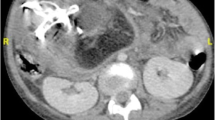Abstract
Ten-year-old Arabian mare was referred to the Veterinary Teaching Hospital of Shahid Bahonar University of Kerman, central Iran, in lateral recumbency with anorexia and severe weakness. On clinical examination, the mare was depressed, tachypneic (55 breaths/min), tachycardic (50 beats/min), and had a body temperature of 36.5 °C. Stronger heart tone than normal was detectable by stethoscope and mucous membranes were hyperemic. At necropsy, a distended uterus containing a large amount of malodorous thin sanguineous exudate, inflammatory debris, and fetal bones indicated fetal maceration that previously had been diagnosed by an inexperienced clinician but had not been cured exactly. Treatment consisting of intravenous administration of isotonic fluids, anti-inflammatory agent, and antibiotic was not successful and the mare died 3 h after the onset of the treatment. The current report is the first report of fetal maceration in Arabian mares and it seems that in the present case, incomplete treatment resulted in the retained fetal materials that caused severe toxemia and death.



Similar content being viewed by others
References
Ball BA (1988) Embryonic loss in mares. Incidence, possible causes, and diagnostic considerations. Vet Clin North Am Equine Pract 4:263–290
Burns TE, Card CE (2000) Fetal maceration and retention of fetal bones in a mare. J Am Vet Med Assoc 217:878–880
Carluccio A, Contri A, Amicis I, Gloria A, Sfirro MP, Mariotti F, Robbe D (2012) Macerazione fetale in un’asina. Ippologia 23:9–14
Claire EC (2011) Fetal maceration and mummification. In: McKinnon AO, Squires EL, Vaala WE, DD Varner, eds. Equine reproduction. 2nd edit. Wiley – Blackwell pub, London, pp: 2373–2375
Heijltjes JM, Rijkenhuizen ABM, Hendriks WK, Stout TAE (2009) Removal by laparoscopic partial ovariohysterectomy of a uterine leiomyoma assumed to have caused fetal death in a mare. Equine Vet Educ 2:198–203
Long S (2009) Abnormal development of the conceptus and its consequences. In: DE Noakes, H Pearson, TJ Parkinson, eds. Veterinary Reproduction and Obstetrics . 9th edit. Philadelphia: WB Saunders Co, pp: 110–133
Nobregal FS, Beck CAC, Ferreira MP (2011) Fetal maceration in pony. Acta Sci Vet 39:1007
Robinson KA, Manning ST (2011) Premature lactation and retention of a mummified fetus with live birth of the co-twin in a primiparous Morgan mare. Can Vet J 52:423–425
Threlfall WR (2005) Equine fetal mummification as a result of progestagen therapy. J Equine Vet Educ 17:235–239
Author information
Authors and Affiliations
Corresponding author
Ethics declarations
Conflict of interest
The authors declare that they have no conflicts of interest.
Ethical approval
This article does not contain any studies with animals performed by any of the authors. This manuscript is a case report and do not have any experimental procedure with animals.
Rights and permissions
About this article
Cite this article
Imani, M., Vosough, D. Death of an Arabian mare due to incomplete treatment of fetal maceration: a case report. Comp Clin Pathol 27, 1723–1725 (2018). https://doi.org/10.1007/s00580-018-2802-6
Received:
Accepted:
Published:
Issue Date:
DOI: https://doi.org/10.1007/s00580-018-2802-6




